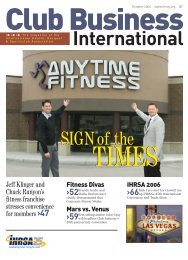Augie In Action! Augie In Action! - Ihrsa
Augie In Action! Augie In Action! - Ihrsa
Augie In Action! Augie In Action! - Ihrsa
You also want an ePaper? Increase the reach of your titles
YUMPU automatically turns print PDFs into web optimized ePapers that Google loves.
whether they be tennis lessons, basketball leagues, or summer sports camps—have higher<br />
retention rates than those who are not involved in group activities.<br />
A higher percentage of members involved in group exercise is a leading indicator for<br />
higher retention. As this percentage increases, so also can one expect that the retention rate<br />
will increase.<br />
Members stay longer with a little help from their friends. Members who socialize with<br />
friends at their clubs have higher retention rates than members whose club experience is<br />
solitary. The proof of this is amply demonstrated anecdotally by the exceptionally high<br />
retention rates among tennis players and, particularly, among contract tennis players (i.e.,<br />
players who contract with their club to play at a particular time every week with the same<br />
group of friends). Typically, death alone diminishes the retention rates of such players. Why?<br />
Because every time such a group gathers to play, they are meeting with their friends not<br />
only for a game of tennis, but also for a social hour or two that often culminates with a beer<br />
or soda after the game.<br />
This, once again, points to the importance of the immense,<br />
relatively untapped potential of creating programs that facilitate<br />
member-to-member interaction.<br />
Four-season, indoor-outdoor family clubs have, on average,<br />
higher retention rates than indoor-only clubs. <strong>In</strong>creasingly,<br />
four-season clubs are occupying a power position within the<br />
industry in two different respects. First, they enjoy an important<br />
competitive advantage with respect to neighboring indoor-only<br />
facilities, and, second, they offer to their members a four-season<br />
value proposition with respect to both membership acquisition<br />
and membership retention.<br />
As a result, there is an increasing number of four-season clubs<br />
today that are as busy, or even busier, in July than they are in<br />
January. These clubs have a huge advantage over indoor-only<br />
clubs when it comes to membership retention.<br />
Declining usage by a member is always a red flag. Declining<br />
usage is a signal that the member’s perception of the value of their Source: IHRSA/ASD Health Club Trend Report 1987-2005<br />
membership is moving in a negative direction. As indicated by<br />
research conducted by Richard Blacklock for Sport and Health,<br />
<strong>In</strong>c., whenever, over a 60-day period, an individual member’s<br />
normal club usage drops by 50% or more, that member is in danger of quitting. For<br />
example: adjusting for the effects of seasonality, if, over a six-month period, a member<br />
had established a usage pattern of two visits per week to the club, and then, during a<br />
subsequent 60-day period, usage fell to less than one visit per week, this is a signal that the<br />
member may be heading toward terminating the membership.<br />
This highlights the importance of computerized tracking systems that can alert clubs to<br />
significant variances in a member’s participation. Such variances are often telltale signs of a<br />
deteriorating relationship between a member and the club.<br />
The likelihood of quitting generally decreases with each year of membership. <strong>In</strong> mature<br />
clubs, i.e., those that have been open two or more years, the attrition rate for people in<br />
their first year of membership is higher than the attrition rate for those in their second<br />
year of membership. —|<br />
– John McCarthy, jmccarthy77@gmail.com<br />
.com<br />
To order IHRSA’s Guide to Membership Retention 2007, please log on to www.ihrsastore.com.<br />
Total Health Club Members<br />
by Length of Current Membership<br />
Average = 4.7 years<br />
















